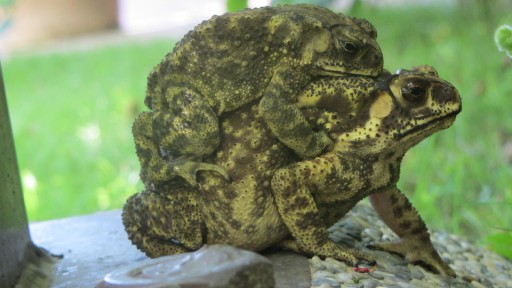Mating Spectacled Toads
Duttaphrynus melanostictus is a toad commonly found in south and east Asia, from India and China to Borneo and Sumatra. It is commonly called “Spectacled Toad” or “Javanese Toad”. A nocturnal amphibian, the species often inhabit farmland and human settlements, feeding mostly on insects. Its colours are rather striking, golden with black ridges; this makes them hard to spot on rocks and naked soil, especially in low-light, but they are distinctive when sitting on top of green vegetation. Females are noticeably larger than males, some growing to as much as 20 cm in length and becoming a lot less dynamic in the process. Young toads are almost entirely black.
Asides from insects, this is the most common animal found in our garden in Taitung. During most of the year (perhaps except for a few weeks in winter when the temperature might drop to as low as 15 °C at night) it’s enough to walk to the front yard if one wants to see them hopping around. Some panic at the sight of an approaching human and quickly look for a thicker vegetation to hide, but many of them are quite docile and easy to catch. Once in a palm, they become motionless – perhaps enjoying the warmth of the human skin or, quite possibly, in a state of shock and unable to move. They often look for a source of light where flying insects might congregate.
I like these amphibians a lot. Unlike many kinds of frogs which can be incredibly loud at night, the spectacled toads make very little noise. They seem to be quite intelligent too – once I accidentally brought a toad into the house where it promptly jumped out of the flower pot and hid behind furniture. I didn’t see it for two days until one morning when it was sitting quietly in front of the door, waiting for me to open it so it can finally get back to its natural habitat. And according to the linked Wikipedia article, their tadpoles are known be recognise kin!
I took the picture of the two mating spectacled toads below during an overcast day. They obviously saw me approach but didn’t move and didn’t show any signs of distress while I circled around them with a camera, looking for the best angle to immortalise the scene. I tried it with and without flash and this one, without flash, seemed to come out the best – showing the texture of the animals’ skins without distorting the colours.
(This page has been viewed 1046 times.)

Leave a Reply